Projects
(2003-2016)
The Werner Committee Network
In March 2015 we started a small pilot project on the communication network of the Werner Committee in the years 1970 to 1972. The goal was to explore the strengths, weaknesses and added values of social network analysis methods for the EIS Department with regard to research and public dissemination.

About the Werner Committee
When the EC Council decided on the composition of the ad hoc group on EMU on 6 March 1970, there were three main reasons for the choice of members. Firstly, responsibility for examining the issues raised by the Hague Summit had to be in the hands of officials in charge of economic and financial policy in the Member States. Secondly, the figures concerned had to be committed to European integration and have considerable experience in this field. Lastly, any solution put forward had to have the widest possible support at government level. The group was formed of the leaders of the various specialised committees of the Commission, who also held high national offices. They were the chairmen of the Monetary Committee (Bernard Clappier, Deputy Governor of the Banque de France), the Committee of Governors of the Central Banks (Hubert Ansiaux, Governor of the National Bank of Belgium), the Medium-Term Economic Policy Committee (Johann Schöllhorn, State Secretary in the Federal Ministry of the Economy), the Conjunctural Policy Committee (Gerard Brouwers, State Secretary in the Dutch Ministry of the Economy) and the Budgetary Committee (Gaetano Stammati, Treasurer-General in the Italian Ministry of the Treasury). The Commission was represented by the Director-General for Economic Affairs (DGII), Ugo Mosca. Werner’s appointment as chair of the group was not just a highly political choice but a considered act in favour of a man with a strong reputation for forging a consensus. One of Werner’s key contributions was in mediating to bring the differing points of view in the committee closer together so as to secure an agreement on the interim report on 20 May 1970 and on the final report on 7 October 1970. Through her research and her analysis of unpublished sources from the Werner family archives, Elena Danescu was able to piece together all the meetings of the Werner Committee in the order in which they occurred, identifying the names of the participants, details of the subjects discussed and the main documents presented, as well as the main schools of thought represented and the influence each of them exerted (Summary of the Werner Committee’s schedule and the main issues addressed (6 March 1970–22 March 1971)).
Werner developed a tradition of ‘network diplomacy’ and leadership in European integration. He forged his ideas by cultivating long-term productive exchanges of views with other instigators of monetary innovation such as Collin, Rueff and Triffin, as well as with financial technocrats including Hubert Ansiaux, Guido Carli, Otmar Emminger and Jelle Zijlstra. Werner remained in close contact with the Action Committee for the United States of Europe, above all with Jean Monnet, Willy Brandt, Walter Hallstein and Robert Marjolin. Werner exerted his influence at various levels of Community decision-making and became a key figure in intellectual debates between monetary elites and in the efforts to establish consensual transnational guidelines on monetary matters.
This pilot project is related to the ‘Pierre Werner and Europe’ research project coordinated by Elena Danescu and based on the private archives of Pierre Werner, which have been opened for the first time for research purposes and to which our researchers have been granted privileged access through a partnership agreement signed with the Werner family (source www.cvce.eu). The University of Luxembourg holds the exclusive rights for the online publication of documents from these archives. See Inventory of the Pierre Werner family archives consulted.
Method
We worked with a selection of 51 items of correspondence and manually extracted detailed relational information on senders and recipients. Relationships within the committee were fairly complex, even among a small group of 25 people; any given two people may have got on very well personally but disagreed on certain topics due to their convictions or professional obligations. In addition, their relationship may have changed over time.
Coding scheme for the collection of relational data. Zeros behind the actual code represent a degree of certainty.
Coding scheme for the collection of attribute data. Zeros behind the actual code represent a degree of certainty.
The coding scheme represents all these dimensions of social relations and allows us to describe any given relationship in detail. Aspects include the topics discussed, the actions associated with the correspondence, any agreements or disagreements, official or unofficial exchanges, estimates of the quality of the personal and professional relationship between sender and recipient, the date and the source document for future reference. Unlike in other communication networks, an edge was not constituted by a letter but by a topic in a letter. Similarly, the coding scheme captures information on personal attributes such as political orientation, nationality, employer, personal convictions, governmental positions and group affiliations. Abstract definitions and examples for each code ensure that our decision-making process and interpretation of the texts is at least to some extent transparent. You can find a more detailed description of this manual data extraction approach online.
Our approach of entering data directly into a spreadsheet is highly robust and simple but suffers from a degree of redundancy: some relationships between two people stay the same and we have to enter the same information time and time again. This became apparent in situations when one person wrote to all the other 14 members of the Werner Committee. The sender of the letter had a specific relationship with each member of the committee. Since we coded on the basis of topics which were discussed in a letter, this would mean a lot of redundancies already if one letter contained three topics: we would have to code the relationship between the sender and every member three times, a total of 42 relationships. To solve this, we developed a Python script which automatically filled in the details of the relationship between sender and the respective members. This allowed us to code a total of 1 128 relationships.
Visualisations
This rich description of the multidimensional relationships between the members of the Werner Committee and those who were closely associated with it can be explored by means of network visualisations. Below we have selected examples which demonstrate the potential of graphic visualisations for revealing unexpected links and gaps as well as clusters. All visualisations were created using NodeXL and RAW.
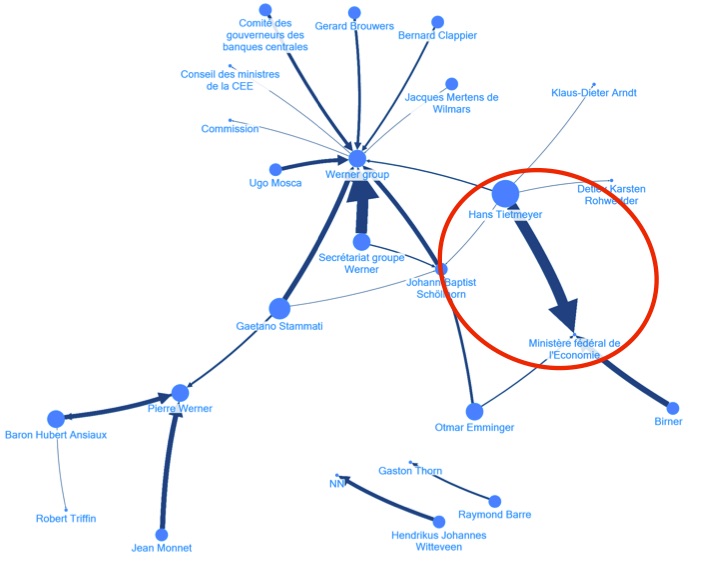
We observe a surprisingly strong relation between Hans Tietmeyer and the German Ministry of the Economy. Visualisation: Henriette Heimbach.
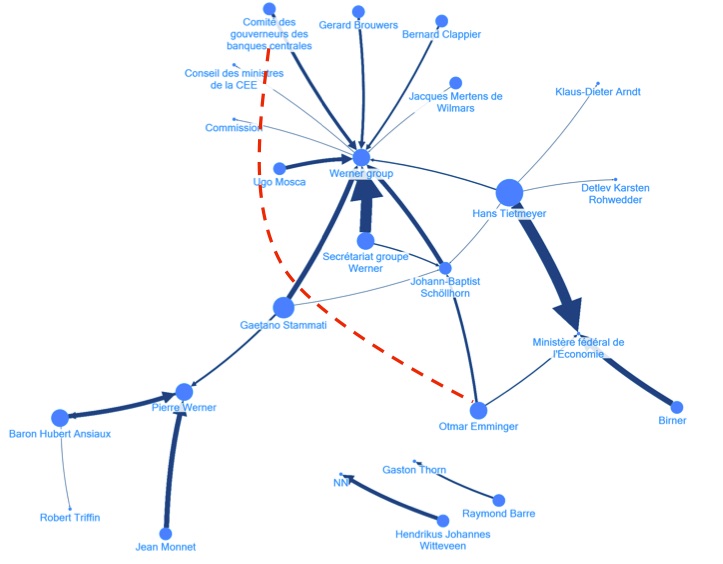
Even though our data set is limited, we were surprised not to find an expected relation between Otmar Emminger and the Committee of Governors of the Central Banks. Visualisation: Henriette Heimbach.
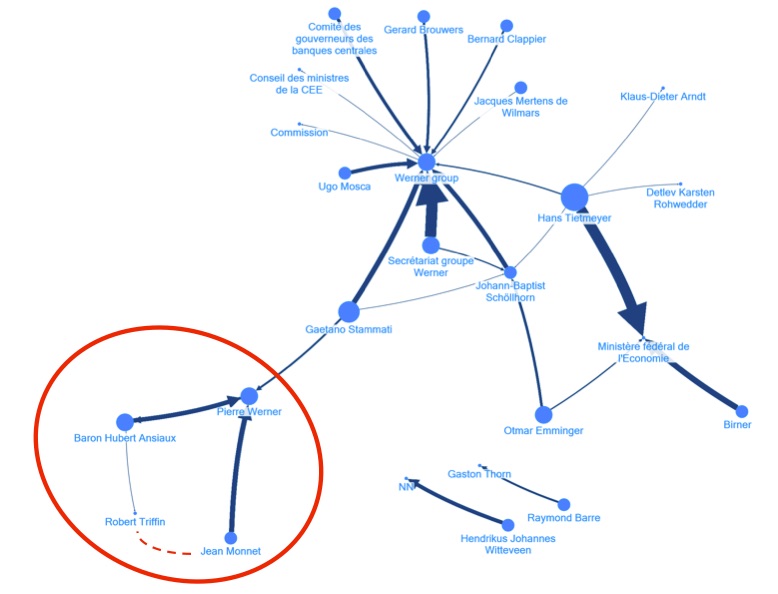
We found an interesting cluster which formed between Baron Hubert Ansiaux, Pierre Werner, Robert Triffin and Jean Monnet. Visualisation: Henriette Heimbach.
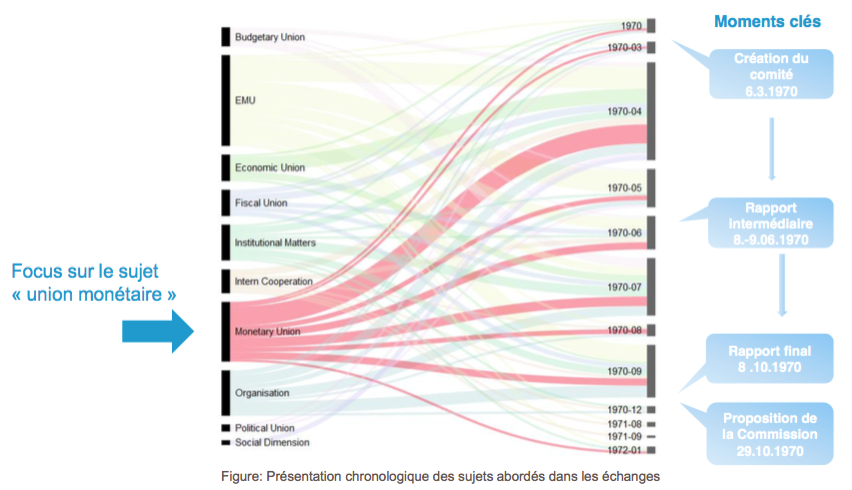
The image reveals the increased importance of the topic ‘Monetary Union’ within the committee with the strongest intensity before the drafting of the interim report. This highlights the prevalence of the monetary dimension in this interim report (EMU had a strong monetary dimension/at that time the ‘monetarists’ appeared to have the upper hand) and also the intensity of the future efforts made by Werner as chairman of the committee in favour of a ‘parallel’ structure of EMU (with a perfect balance between the economic and the monetary pillars). Visualisation: Henriette Heimbach.
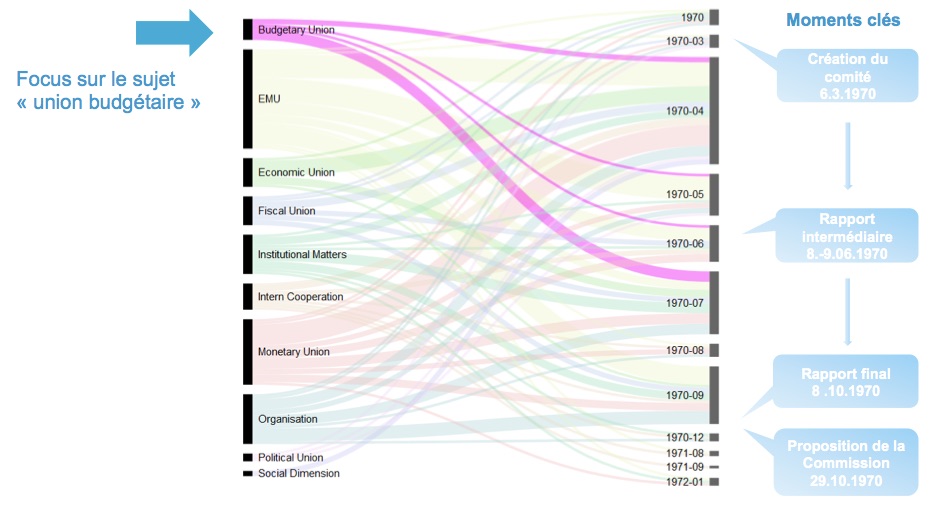
This image shows that the topic ‘Budgetary Union’ was discussed in the committee from the very beginning and more intensely when the drafting of the final report was under way. In view of the political disagreement between members, in the final report this topic was not treated in depth but only touched upon briefly. This subject is still on the agenda for EMU! Visualisation: Henriette Heimbach.
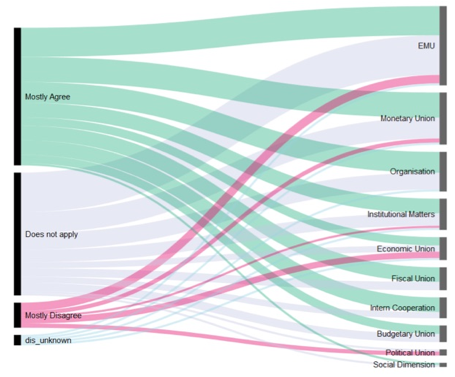
Visualisation: Henriette Heimbach.
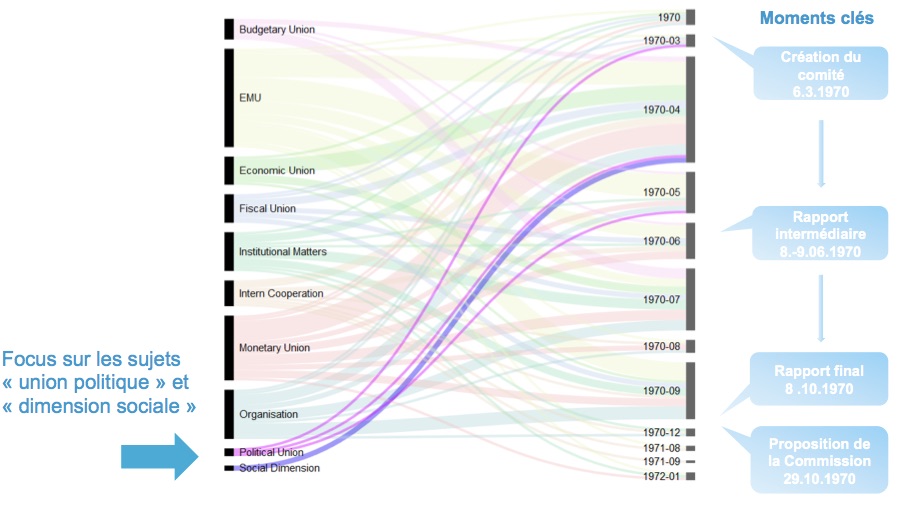
Visualisation: Henriette Heimbach.
Results and future work
The examples above demonstrate that the data visualisations revealed surprisingly strong relations, unexpectedly missing relations and clusters among the members. All these results must be considered preliminary but they do suggest that the ‘economist’ vs ‘monetarist’ dispute was in fact less clear-cut than previously thought, that there was close, ongoing contact between German institutions and the German members of the Werner Committee and that the Bundesbank was more active in national interinstitutional cooperation than within the Committee of Governors of the Central Banks.
The scope of this pilot project was limited: the aim was to explore the feasibility and added value of network analysis methods for EIS research in general and for our understanding of the dynamics inside the Werner Committee in particular. We found that visualisations can indeed open up a novel perspective on well-studied documents, raise relevant questions and function as a tool for the public dissemination of research insights. Our approach has confirmed and consolidated the conclusions of traditional research and shed new light on the information in primary sources over and above the possibilities of traditional human interpretation.
The data we collected from this relatively small number of documents and its visual representation offer promising leads. At this stage, however, we need to include more documents in the sample before we can confirm our initial observations and make more substantial statements about the dynamics inside the committee. In order to substantiate our preliminary observations, we need to broaden the selection of documents in general and to include confidential exchanges in particular.
Project team
Dr Marten Düring
Dr Elena Danescu
Henriette Heimbach


